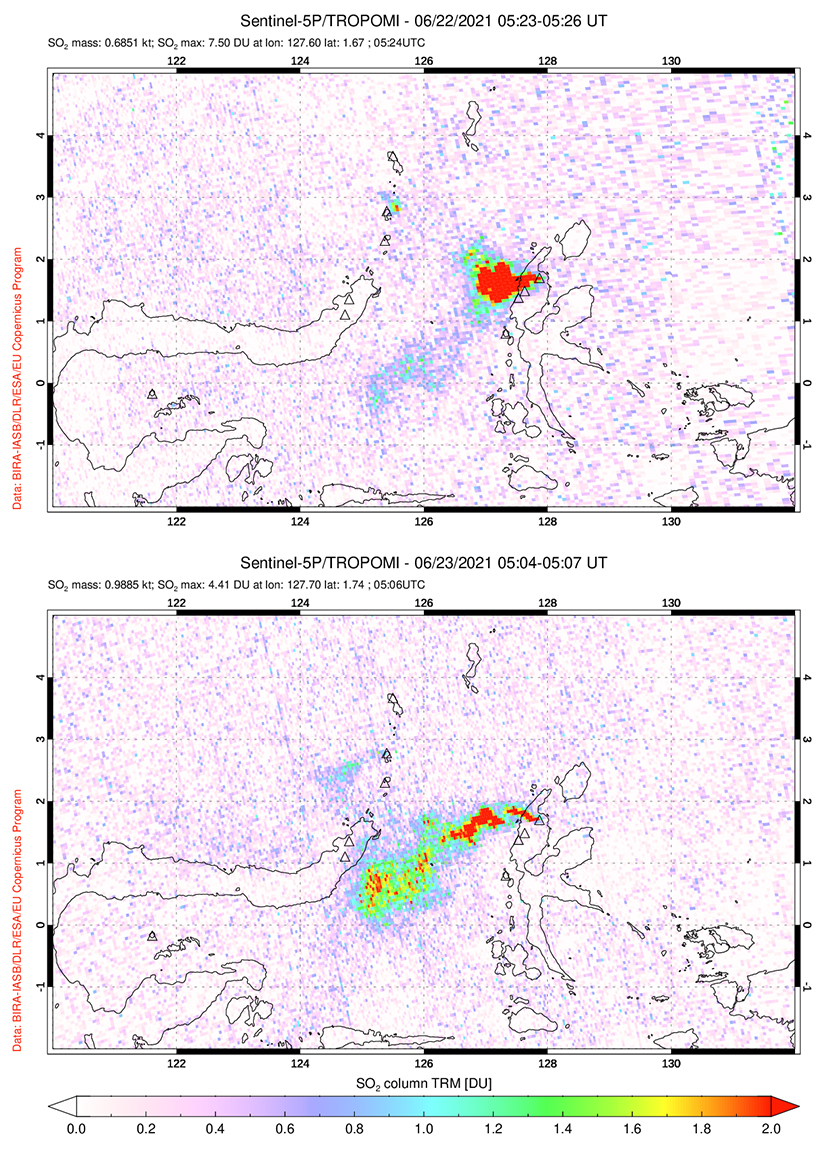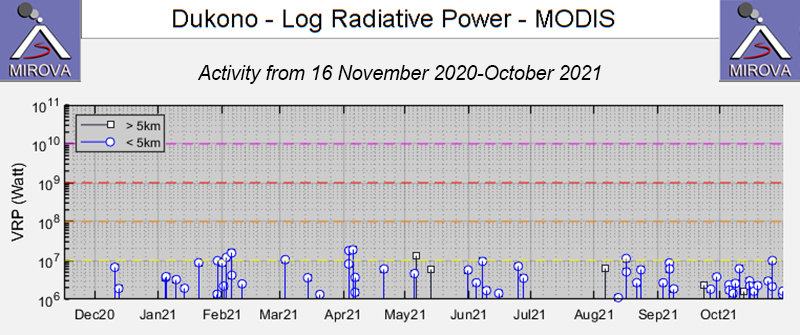Report on Dukono (Indonesia) — November 2021
Bulletin of the Global Volcanism Network, vol. 46, no. 11 (November 2021)
Managing Editor: Edward Venzke.
Research and preparation by Paul Berger.
Dukono (Indonesia) Ash and sulfur dioxide plumes continue during April-September 2021
Please cite this report as:
Global Volcanism Program, 2021. Report on Dukono (Indonesia) (Venzke, E., ed.). Bulletin of the Global Volcanism Network, 46:11. Smithsonian Institution. https://doi.org/10.5479/si.GVP.BGVN202111-268010
Dukono
Indonesia
1.6992°N, 127.8783°E; summit elev. 1273 m
All times are local (unless otherwise noted)
The ongoing volcanic activity at Dukono has consisted of frequent ash explosions and sulfur dioxide emissions (BGVN 46:04). This activity continued during March-September 2021. The data below were primarily provided by the Pusat Vulkanologi dan Mitigasi Bencana Geologi (PVMBG), also known as the Center for Volcanology and Geological Hazard Mitigation (CVGHM), the Darwin Volcanic Ash Advisory Centre (VAAC), and satellite sensors. Since 15 June 2008 the Alert Level has remained at 2 (on a scale of 1-4) and the public has been warned to remain outside of the 2-km exclusion zone.
Numerous weak ash explosions continued during April-September 2021, generating plumes that rose to altitudes of 1.3-2.4 km and drifted in multiple directions (figure 24). Plume elevations reported by PVMBG ranged from 100 to 800 m above the summit (1.3-2.0 km altitude), somewhat lower than those reported by the Darwin VAAC (1.8-2.4 km altitude). One news report (Halmahera Post.com) in mid-April stated that heavy ash fell on the town of Tobelo (13 km ENE); an official with PVMBG was quoted in that report as suggesting that some of the ashfall was due to explosions caused by frequent rainfall at the summit. Although meteorological clouds usually obscured views, Sentinel-2 satellite images on 5 April and 19 July clearly showed the ash plumes (figure 25).
 |
Figure 24. Ash plumes from rising Dukono are visible in this webcam photo on 20 April 2021. Courtesy of MAGMA Indonesia. |
Strong SO2 plumes were evident during at least half the days during the reporting period. The plumes were especially intense and extensive during May and June (figure 26). MIROVA thermal alerts were intermittent and primarily of low power during April-September 2021, with a slight spike in numbers in early April (figure 27). In its 30 September 2021 Disaster report, PVMBG stated that seismograph recordings had shown continuous tremor, with amplitudes 0.5-2 mm, with 1 mm predominating
Geological Summary. Reports from this remote volcano in northernmost Halmahera are rare, but Dukono has been one of Indonesia's most active volcanoes. More-or-less continuous explosive eruptions, sometimes accompanied by lava flows, have occurred since 1933. During a major eruption in 1550 CE, a lava flow filled in the strait between Halmahera and the N-flank Gunung Mamuya cone. This complex volcano presents a broad, low profile with multiple summit peaks and overlapping craters. Malupang Wariang, 1 km SW of the summit crater complex, contains a 700 x 570 m crater that has also been active during historical time.
Information Contacts: Pusat Vulkanologi dan Mitigasi Bencana Geologi (PVMBG, also known as Indonesian Center for Volcanology and Geological Hazard Mitigation, CVGHM), Jalan Diponegoro 57, Bandung 40122, Indonesia (URL: http://www.vsi.esdm.go.id/); MAGMA Indonesia, Kementerian Energi dan Sumber Daya Mineral (URL: https://magma.esdm.go.id/v1); Darwin Volcanic Ash Advisory Centre (VAAC), Bureau of Meteorology, Northern Territory Regional Office, PO Box 40050, Casuarina, NT 0811, Australia (URL: http://www.bom.gov.au/info/vaac/); NASA Global Sulfur Dioxide Monitoring Page, Atmospheric Chemistry and Dynamics Laboratory, NASA Goddard Space Flight Center (NASA/GSFC), 8800 Greenbelt Road, Goddard, Maryland, USA (URL: https://so2.gsfc.nasa.gov/); Sentinel Hub Playground (URL: https://www.sentinel-hub.com/explore/sentinel-playground); MIROVA (Middle InfraRed Observation of Volcanic Activity), a collaborative project between the Universities of Turin and Florence (Italy) supported by the Centre for Volcanic Risk of the Italian Civil Protection Department (URL: http://www.mirovaweb.it/); Halmahera Post (URL: https://halmaherapost.com/).




